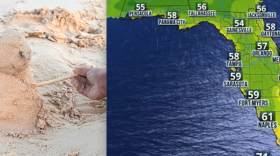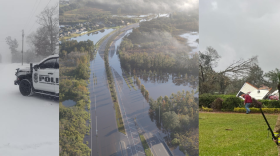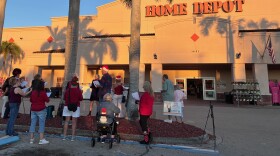As often happens when Florida’s short winter turns to spring, wildfire first finds fuel among the woods in the Panhandle.
A flicker in March grew to a blaze that scorched more than 34,000 acres in three counties amid the dead trees and dried vegetation left in the wake of Category 5 Hurricane Michael in 2018.
In what is today’s Interstate 10’s east-west corridor, millions of pines have been planted during the last century by St. Joe Company, a lumber producer-turned-land developer, and Michael’s top winds of 155 miles per hours felled and splintered an untold number of trees.
In the three years since, Florida’s heat turned timber into tinder until the region burned last month.
Then, also as in many years past, the threat of wildfire shifted to South Florida.
Today, every place where listeners can hear WGCU FM over the air is where the threat of wildfire has firefighters on "high alert," according to Florida Forest Service officials and the Keetch-Byram Drought Index, which is a measure of the lack of moisture in the soil.
That includes the region from Sarasota County south to Monroe County, Charlotte, Lee and Collier counties east to Highlands, Glades and Hendry counties, and even tiny forests on islands just north of Key West.
“The Florida Forest Service have been aware of the potentially elevated levels of fire danger that have been predicted throughout the first months of the year,” said Miguel Nevarez, a Florida Forest Service wildfire mitigation specialist in the Okeechobee District. “We are going to continue to make sure we stay on high alert for any future wildfires to come.”
Nevarez said a reason for the drought conditions is that many parts of South Florida have seen consistent moderate-to-high fire danger levels since the beginning of 2022 due in large part to the region being in a “La Nina” climate condition. La Nina normally results in drier than normal conditions and lower rainfall.
In Florida, more than eight of ten wildfires are caused by people. Some are on lit purpose, but most are caused by a lack of maintenance on equipment that interacts with the ground and is not properly maintained or used.
For example, an out-of-tune lawn mower or a vehicle's old catalytic converter can allow the piece of machinery to get very hot as it runs though underbrush. Chains, like those to secure a boat or trailer, left unhooked will drag on the road behind a vehicle and send sparks flying.
Nevarez said people light campfires on gusty days without thinking about wind-driven sparks. Trains that crisscross the state can sometimes send sparks out from between their wheels and the tracks in areas where the foliage has not been cut back. All of those things can start a wildfire by mistake.
“Now, we may not be able to prevent natural weather such as lighting storms,” Nevarez said, “but we can be more aware of our individual actions to help prevent wildfires from occurring.”
National fire weather agencies are warning about conditions in Florida in April.
The Weather Company and Atmospheric G2 calls for temperatures to be near or slightly below average for April as a whole from the Northwest into the Northern Plains, Great Lakes, Ohio Valley and even parts of the mid-South. But above-average temperatures are also most likely in the Southwest, Florida, and northern New England.
The companies want those at threat of wildfire to remember that the outlook is an overall trend for the entire month. There could be periods that are warmer or cooler, or wetter or dryer, in each respective region of the country when compared to what is shown, but that does not mean the forecast has changed.
The Florida Forest Service said homeowners living in woodsy areas can do things now to help save their homes in case of a wildfire. That 's because once a homeowner can smell the smoke it's often time to leave.
1. Clean roofs and gutters of dead leaves, debris and pine needles that could catch embers
2. Clean debris from exterior attic vents
3. Clean and remove any dead debris from underneath decks or porches
4. Repair or replace any damaged or loose window screens
5. Keep up with normal lawn care and home maintenance.
Environmental reporting for WGCU is funded in part by the VoLo Foundation, a non-profit with a mission to accelerate change and global impact by supporting science-based climate solutions, enhancing education, and improving health.
If you'd like to receive a monthly digital newsletter on the environment from WGCU, sign up here.








